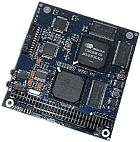 Model 516
MPEG-2/1 Frame Grabber and Video Encoder/Decoder
Model 516 is a PC/104 frame grabber that captures and transfers full-frame (640 x 480) video at 30 frames per second. It overcomes the low bandwidth of the PC/104 bus by using hardware compression to produce encoded MPEG-2 and MPEG-1 data streams of 440 kbits to 10 Mbits per second. It also has two audio input channels that are synchronized to the MPEG data.
Advantages
MPEG2 data reduces the amount of memory required to store full motion video. The compressed data requires a smaller transmission bandwidth. This makes it possible to transmit 30 frames/sec video and audio over the PC/104 bus or over a 10/100 Base-T Ethernet. The hardware compression circuit uses a motion estimation algorithm to produce smooth images from interlaced cameras. The length of MPEG2 video streams is not limited by the viewing software.
Decompression
Encoded MPEG2 data can also be decompressed by the 516’s hardware to produce composite video and audio. The video output is available at a flat cable header. The audio output is available at an audio jack and the flat cable header.
Video channels
The 516 has four multiplexed video channels that function as four separate composite channels or as two S-video inputs. Only one channel can be compressed at a time
Digital I/O
Two bi-directional logic lines are under software control.
Text caption buffer
A 64 character buffer is available for adding text to each frame. The text is within a transparent box that may be positioned anywhere within the frame.
Self test
Digitized video and audio inputs can be looped back to the output circuits to allow camera and sound adjustments. The 516’s D/A can be programmed to generate color test bars. This is useful for testing the video output channel.
Lost video detection
The status of the camera’s vertical and horizontal sync signals may be used to detect the presence or absence of the camera signal. The included software allows reading these signals to detect a lost video signal.
Model 516
MPEG-2/1 Frame Grabber and Video Encoder/Decoder
Model 516 is a PC/104 frame grabber that captures and transfers full-frame (640 x 480) video at 30 frames per second. It overcomes the low bandwidth of the PC/104 bus by using hardware compression to produce encoded MPEG-2 and MPEG-1 data streams of 440 kbits to 10 Mbits per second. It also has two audio input channels that are synchronized to the MPEG data.
Advantages
MPEG2 data reduces the amount of memory required to store full motion video. The compressed data requires a smaller transmission bandwidth. This makes it possible to transmit 30 frames/sec video and audio over the PC/104 bus or over a 10/100 Base-T Ethernet. The hardware compression circuit uses a motion estimation algorithm to produce smooth images from interlaced cameras. The length of MPEG2 video streams is not limited by the viewing software.
Decompression
Encoded MPEG2 data can also be decompressed by the 516’s hardware to produce composite video and audio. The video output is available at a flat cable header. The audio output is available at an audio jack and the flat cable header.
Video channels
The 516 has four multiplexed video channels that function as four separate composite channels or as two S-video inputs. Only one channel can be compressed at a time
Digital I/O
Two bi-directional logic lines are under software control.
Text caption buffer
A 64 character buffer is available for adding text to each frame. The text is within a transparent box that may be positioned anywhere within the frame.
Self test
Digitized video and audio inputs can be looped back to the output circuits to allow camera and sound adjustments. The 516’s D/A can be programmed to generate color test bars. This is useful for testing the video output channel.
Lost video detection
The status of the camera’s vertical and horizontal sync signals may be used to detect the presence or absence of the camera signal. The included software allows reading these signals to detect a lost video signal.
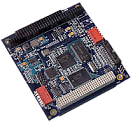 Model 314
MPEG-4/2/1 and MJPEG Frame Grabber
Model 314 is a low-cost MPEG-4/2/1 and MJPEG frame grabber that captures full-frame (720 x 480) video at 30 frames per second. Uncompressed video is available through the PC/104+ bus for previewing. It also has two synchronized audio input channels and on screen display of text (OSD).
Advantages of compression
MPEG and MJPEG data reduces the amount of memory required to store full motion video. The compressed data requires a smaller transmission bandwidth. MJPEG data is typically compressed by a factor 20 while MPEG-2 and -4 by a factor of 100. Image compression makes it possible to transmit 30 frames/sec of MPEG video over the PC/104+ bus. The hardware compression circuit uses a motion estimation algorithm to produce smooth images from interlaced cameras.
Uncompressed capture
The 314 can function as a conventional frame grabber by supplying uncompressed video with low latency and snapshots of single frames. A lower cost version, 314NC, is available without the compression circuitry and the on screen display. It uses the newest 9-bit digitizer technology plus an adaptive multi-line comb filter to produce higher quality images than those using BT878 technology.
On screen display
A 96 character buffer is available for adding text to each frame. The text is within a transparent box that may be positioned anywhere within the frame. This function is not available on the 314NC.
Motion detection
The 314 performs motion detection in three user programmable regions of interest. For each separate region of interest, the user can set up different motion detection sensitivity. Within the regions of interest motion can be further localized to a 16x16 pixel block. The following links show examples of the motion detection setup menu for Windows and the regions of interest. The motion map shows where the motion was detected. (Please see image under the tab: Images and Mechanical Drawings).
Audio multiplexing
Digitized audio from the 314 is multiplexed into MPEG streams by a Sensoray-supplied software in SDK. Hence, the 314 does perform A/V multiplexing as does model 516 and 616. External signals connect to the 314 via a 24-pin header. Sensoray’s optional 314TA video termination board provides BNC connections for the 314’s composite video inputs.
Model 314
MPEG-4/2/1 and MJPEG Frame Grabber
Model 314 is a low-cost MPEG-4/2/1 and MJPEG frame grabber that captures full-frame (720 x 480) video at 30 frames per second. Uncompressed video is available through the PC/104+ bus for previewing. It also has two synchronized audio input channels and on screen display of text (OSD).
Advantages of compression
MPEG and MJPEG data reduces the amount of memory required to store full motion video. The compressed data requires a smaller transmission bandwidth. MJPEG data is typically compressed by a factor 20 while MPEG-2 and -4 by a factor of 100. Image compression makes it possible to transmit 30 frames/sec of MPEG video over the PC/104+ bus. The hardware compression circuit uses a motion estimation algorithm to produce smooth images from interlaced cameras.
Uncompressed capture
The 314 can function as a conventional frame grabber by supplying uncompressed video with low latency and snapshots of single frames. A lower cost version, 314NC, is available without the compression circuitry and the on screen display. It uses the newest 9-bit digitizer technology plus an adaptive multi-line comb filter to produce higher quality images than those using BT878 technology.
On screen display
A 96 character buffer is available for adding text to each frame. The text is within a transparent box that may be positioned anywhere within the frame. This function is not available on the 314NC.
Motion detection
The 314 performs motion detection in three user programmable regions of interest. For each separate region of interest, the user can set up different motion detection sensitivity. Within the regions of interest motion can be further localized to a 16x16 pixel block. The following links show examples of the motion detection setup menu for Windows and the regions of interest. The motion map shows where the motion was detected. (Please see image under the tab: Images and Mechanical Drawings).
Audio multiplexing
Digitized audio from the 314 is multiplexed into MPEG streams by a Sensoray-supplied software in SDK. Hence, the 314 does perform A/V multiplexing as does model 516 and 616. External signals connect to the 314 via a 24-pin header. Sensoray’s optional 314TA video termination board provides BNC connections for the 314’s composite video inputs.
 Model 2446
Streaming Video Server with HD image capture
Model 2446 is a streaming video server. It compresses either standard or high definition video and synchronized audio into an MPEG format and transmits it over an Ethernet connection using the UDP or RTP protocol. The internal CPU runs an embedded Linux operating system, with hardware compression performed by the Model 2246. The encoded video is playable by commercial set top boxes such as the Amino or PC’s running free open source software like VideoLan. The 1U enclosure fits any standard 18” server rack and can be mounted in either direction.
Latency
Depending on network conditions, the video into the 2446 can be encoded, transmitted, and displayed by a remote network decoder in less than a second.
On Screen Display (OSD)
Eight separate regions of graphics and/or text can be displayed. A total of 64k pixels is available (32k double buffered). The text style can be selected from any true-type font; graphics are displayed from standard .bmp files. There is an API to place and move graphics anywhere on the screen. OSD graphics may be edited from a remote Ethernet node and viewed by other observers on the network.
Ethernet
Ethernet based streaming is transmitted via transport stream over an Ethernet connection.
Image Processing
The 2446’s scan converter guarantees the DVI output is synchronized to LCD displays. 25 frame/second PAL sources will be displayed at the highest LCD refresh rate. Real-time image down scaling of the HDTV stream prepares it for MPEG compression.
Embedded Linux
The 2446 is pre-configured with an embedded Linux operating system for high reliability and fast response.
Video outputs
Four types of video outputs are available including an SDI video stream containing the bit-map image and text overlays. The interface to an LCD display is via a DVI port and the interface to the host computer is via a USB port. Composite video and S-video outputs are also provided. All outputs are generated and scaled from a common input source.
Model 2446
Streaming Video Server with HD image capture
Model 2446 is a streaming video server. It compresses either standard or high definition video and synchronized audio into an MPEG format and transmits it over an Ethernet connection using the UDP or RTP protocol. The internal CPU runs an embedded Linux operating system, with hardware compression performed by the Model 2246. The encoded video is playable by commercial set top boxes such as the Amino or PC’s running free open source software like VideoLan. The 1U enclosure fits any standard 18” server rack and can be mounted in either direction.
Latency
Depending on network conditions, the video into the 2446 can be encoded, transmitted, and displayed by a remote network decoder in less than a second.
On Screen Display (OSD)
Eight separate regions of graphics and/or text can be displayed. A total of 64k pixels is available (32k double buffered). The text style can be selected from any true-type font; graphics are displayed from standard .bmp files. There is an API to place and move graphics anywhere on the screen. OSD graphics may be edited from a remote Ethernet node and viewed by other observers on the network.
Ethernet
Ethernet based streaming is transmitted via transport stream over an Ethernet connection.
Image Processing
The 2446’s scan converter guarantees the DVI output is synchronized to LCD displays. 25 frame/second PAL sources will be displayed at the highest LCD refresh rate. Real-time image down scaling of the HDTV stream prepares it for MPEG compression.
Embedded Linux
The 2446 is pre-configured with an embedded Linux operating system for high reliability and fast response.
Video outputs
Four types of video outputs are available including an SDI video stream containing the bit-map image and text overlays. The interface to an LCD display is via a DVI port and the interface to the host computer is via a USB port. Composite video and S-video outputs are also provided. All outputs are generated and scaled from a common input source.
 Model 2255
4 Channel USB Frame Grabber
The Model 2255 frame grabber accepts NTSC or PAL video on 4 composite inputs. Digitized images are sent to the host computer via USB 2.0 high-speed interface. A variety of output formats supported by the 2255 eliminates the need for format conversions in a wide range of applications. Supported formats are:
1. RGB packed (24 bits/pixel, bitmap compatible)
2. YCrCb packed (16 bits/pixel, YUY2 compatible)
3. YCrCb planar (16 bits/pixel, optimal for image processing)
4. Y8 (8 bits/pixel, monochrome).
Low Latency
The 2255’s allows fast visual feedback because of its low latency. Its internal DSP optimizes the four data streams for efficient USB 2.0 communication. The Windows drivers are also optimized for low latency. The overall latency is no more than 50 ms for NTSC and 60 ms for PAL.
Deinterlacing
Model 2255 performs optional deinterlacing of interlaced video to reduce motion artifacts on captured images. The lines of one of the fields of video are recreated from those of another field by using interpolation. This method provides better visual quality compared to simple line doubling. Since the deinterlacing is performed by the firmware running on the DSPs, it slows the capture rate down slightly. A visual example is provided here.
JPEG Compression
An optional firmware file is available for purchase that enables hardware JPEG compression on the 2255. The optional firmware allows JPEG capture at up to 60 total frames per second from all channels, or 2 channels at 30 fps, or 4 channels at 15 fps. The standard free SDK will allow a user to preview the JPEG capture capability but adds a black bar across the image. Standard uncompressed features are fully supported by our standard SDK.
Model 2255
4 Channel USB Frame Grabber
The Model 2255 frame grabber accepts NTSC or PAL video on 4 composite inputs. Digitized images are sent to the host computer via USB 2.0 high-speed interface. A variety of output formats supported by the 2255 eliminates the need for format conversions in a wide range of applications. Supported formats are:
1. RGB packed (24 bits/pixel, bitmap compatible)
2. YCrCb packed (16 bits/pixel, YUY2 compatible)
3. YCrCb planar (16 bits/pixel, optimal for image processing)
4. Y8 (8 bits/pixel, monochrome).
Low Latency
The 2255’s allows fast visual feedback because of its low latency. Its internal DSP optimizes the four data streams for efficient USB 2.0 communication. The Windows drivers are also optimized for low latency. The overall latency is no more than 50 ms for NTSC and 60 ms for PAL.
Deinterlacing
Model 2255 performs optional deinterlacing of interlaced video to reduce motion artifacts on captured images. The lines of one of the fields of video are recreated from those of another field by using interpolation. This method provides better visual quality compared to simple line doubling. Since the deinterlacing is performed by the firmware running on the DSPs, it slows the capture rate down slightly. A visual example is provided here.
JPEG Compression
An optional firmware file is available for purchase that enables hardware JPEG compression on the 2255. The optional firmware allows JPEG capture at up to 60 total frames per second from all channels, or 2 channels at 30 fps, or 4 channels at 15 fps. The standard free SDK will allow a user to preview the JPEG capture capability but adds a black bar across the image. Standard uncompressed features are fully supported by our standard SDK.
 Model 817
PCI Express JPEG Frame Grabber
Model 817 combines the functions of a frame grabber, hardware JPEG encoder, and 16 X 4 video crosspoint switch, into a PCI-express (x1) card. It is capable of capturing full resolution color JPEG-compressed images and / or monochrome uncompressed bitmaps, from 16 channels at full NTSC or PAL frame rates.
Frame rate
Four identical video capture and processing units (VCPU) work together to compress JPEG images at 30fps on all 16 channels simultaneously for a total board throughput of 480 fps for 640 X 480 interlaced frames.
Hardware compression
Model 817 executes hardware JPEG compression to reduce the amount of disk space required to store images. Hardware compression greatly reduces the load on the CPU.
Multiple boards
Sensorays driver supports multiple 817s in the same computer.
Real-time outputs
A 16x4 analog crosspoint video switch is used to route any combination of four input channels to external video monitors. Each of the four video outputs can be individually turned on or off, which allows connecting the outputs of multiple 817s to the same monitor.
Text Overlay
An optional single line text caption (up to 80 characters) can be overlaid on the captured images (before compression).
Deinterlacing
Model 817 performs optional deinterlacing of interlaced video to reduce motion artifacts on captured images. The lines of one of the fields of video are recreated from those of another field by using interpolation. This method provides better visual quality compared to simple line doubling. Since the deinterlacing is performed by the firmware running on the DSPs, it slows the capture rate down slightly. A visual example is provided here.
Model 817
PCI Express JPEG Frame Grabber
Model 817 combines the functions of a frame grabber, hardware JPEG encoder, and 16 X 4 video crosspoint switch, into a PCI-express (x1) card. It is capable of capturing full resolution color JPEG-compressed images and / or monochrome uncompressed bitmaps, from 16 channels at full NTSC or PAL frame rates.
Frame rate
Four identical video capture and processing units (VCPU) work together to compress JPEG images at 30fps on all 16 channels simultaneously for a total board throughput of 480 fps for 640 X 480 interlaced frames.
Hardware compression
Model 817 executes hardware JPEG compression to reduce the amount of disk space required to store images. Hardware compression greatly reduces the load on the CPU.
Multiple boards
Sensorays driver supports multiple 817s in the same computer.
Real-time outputs
A 16x4 analog crosspoint video switch is used to route any combination of four input channels to external video monitors. Each of the four video outputs can be individually turned on or off, which allows connecting the outputs of multiple 817s to the same monitor.
Text Overlay
An optional single line text caption (up to 80 characters) can be overlaid on the captured images (before compression).
Deinterlacing
Model 817 performs optional deinterlacing of interlaced video to reduce motion artifacts on captured images. The lines of one of the fields of video are recreated from those of another field by using interpolation. This method provides better visual quality compared to simple line doubling. Since the deinterlacing is performed by the firmware running on the DSPs, it slows the capture rate down slightly. A visual example is provided here.
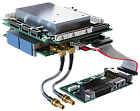 ADLVIS-1660
Coaxpress PCIE/104 solution
The ADLVIS-1660 Dual CXP-6 is a rugged, small form factor (SFF) CoaXPress solution intended for military and industrial applications. It’s a two-board small form factor PCIe/104 solution featuring a Quad Intel i7-4700EQ processor with a dual CXP-6 module using the x16 PCIe/104 bus resulting is a stunning 1,250 MB/s effective camera bandwidth.
The ADLVIS-1660 features include small outline coaxial cabling for DIN1.0/2.3 connectors optimized for SFF design. It supports PoCXP, is GENICAM compliant and includes Euresys Memento event logging for efficient application software development. A second CXP-6 module can easily be added to support four 1xCXP-6 cameras or two 2xCXP-6 cameras.
The ADLVIS-1660 targets rugged, small form factor industrial high-performance vision solutions in a host of military and industrial environments. It enables very high-definition applications as well as high-framerate applications in less than ideal environments for security and surveillance, traffic management, science, machine vision and a vast range of next-generation vision products.
Applications: Hyperspectral Imaging, Traffic Surveillance, Security Monitoring and Control, Unmanned Systems — High-Resolution Image/Video Capture, High-Speed Automated Optical Inspection, Very High-Resolution Line-Scan Image Acquisition, Military and Defense ISR, High Frame-Rate Motion Analysis and Recording.
ADLVIS-1660
Coaxpress PCIE/104 solution
The ADLVIS-1660 Dual CXP-6 is a rugged, small form factor (SFF) CoaXPress solution intended for military and industrial applications. It’s a two-board small form factor PCIe/104 solution featuring a Quad Intel i7-4700EQ processor with a dual CXP-6 module using the x16 PCIe/104 bus resulting is a stunning 1,250 MB/s effective camera bandwidth.
The ADLVIS-1660 features include small outline coaxial cabling for DIN1.0/2.3 connectors optimized for SFF design. It supports PoCXP, is GENICAM compliant and includes Euresys Memento event logging for efficient application software development. A second CXP-6 module can easily be added to support four 1xCXP-6 cameras or two 2xCXP-6 cameras.
The ADLVIS-1660 targets rugged, small form factor industrial high-performance vision solutions in a host of military and industrial environments. It enables very high-definition applications as well as high-framerate applications in less than ideal environments for security and surveillance, traffic management, science, machine vision and a vast range of next-generation vision products.
Applications: Hyperspectral Imaging, Traffic Surveillance, Security Monitoring and Control, Unmanned Systems — High-Resolution Image/Video Capture, High-Speed Automated Optical Inspection, Very High-Resolution Line-Scan Image Acquisition, Military and Defense ISR, High Frame-Rate Motion Analysis and Recording.
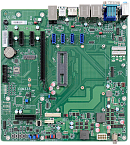 COM335
COM Express Carrier Board
DFI’s carrier board (also known as base board or evaluation board) offers a flexible engineering development environment for COM Express Type 10, Type 7, Type 6, Type 2, and Qseven. Which helps our customers minimize integration requirements while reducing development time and cost.
COM335
COM Express Carrier Board
DFI’s carrier board (also known as base board or evaluation board) offers a flexible engineering development environment for COM Express Type 10, Type 7, Type 6, Type 2, and Qseven. Which helps our customers minimize integration requirements while reducing development time and cost.
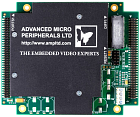 DXStream-HDMI
Ultra Low Latency Standalone H.264 Streaming Client
The DXStream-HDMI is an intelligent, stand-alone, ultra-low latency H.264 streaming client that receives, decodes, and displays H.264 encoded video streams. The DXStream‑HDMI supports the industry standard RTP/RTSP protocols for streaming data via the integrated 100/1000MBit Ethernet connection. This SWaP optimised solution is ideal for rapid deployment in demanding applications in Military, Communications, Transportation, Mining and Energy industries.
The DXStream-HDMI features a dedicated hardware decode engine capable of decoding up to 1080p60 H.264 video at full size and full frame-rate with Ultra Low Latency (under 60ms). The intelligent streaming client is configured via a web interface and once configured the DXStream-HDMI runs autonomously without any user interaction.
The DXStream-HDMI is an intelligent stand-alone device with it’s own on-board CPU and does not require a host CPU or any driver or OS software. For mechanical convenience, the module can be mounted on a PC/104 stack without consuming host CPU resources.
Highlights
Real-time H.264 decode at up to 1080p60
Ultra Low Latency technology with latency below 60ms
H.264/MPEG-4 AVC (Part 10) Decoder
HDMI/DVI output
RTSP/RTP streaming protocol support
Single, rugged, real-time video streaming client solution
Stand-alone operation
Web interface for configuration
Standard PC/104 mechanical form factor
Applications
All-round Real-Time Situational Awareness
Real-time video feedback from remote platforms
Unmanned vehicles (UAV, ROV)
Real-time IP video distribution
Remote Video Surveillance
Border Security
Traffic Monitoring and Control
DXStream-HDMI
Ultra Low Latency Standalone H.264 Streaming Client
The DXStream-HDMI is an intelligent, stand-alone, ultra-low latency H.264 streaming client that receives, decodes, and displays H.264 encoded video streams. The DXStream‑HDMI supports the industry standard RTP/RTSP protocols for streaming data via the integrated 100/1000MBit Ethernet connection. This SWaP optimised solution is ideal for rapid deployment in demanding applications in Military, Communications, Transportation, Mining and Energy industries.
The DXStream-HDMI features a dedicated hardware decode engine capable of decoding up to 1080p60 H.264 video at full size and full frame-rate with Ultra Low Latency (under 60ms). The intelligent streaming client is configured via a web interface and once configured the DXStream-HDMI runs autonomously without any user interaction.
The DXStream-HDMI is an intelligent stand-alone device with it’s own on-board CPU and does not require a host CPU or any driver or OS software. For mechanical convenience, the module can be mounted on a PC/104 stack without consuming host CPU resources.
Highlights
Real-time H.264 decode at up to 1080p60
Ultra Low Latency technology with latency below 60ms
H.264/MPEG-4 AVC (Part 10) Decoder
HDMI/DVI output
RTSP/RTP streaming protocol support
Single, rugged, real-time video streaming client solution
Stand-alone operation
Web interface for configuration
Standard PC/104 mechanical form factor
Applications
All-round Real-Time Situational Awareness
Real-time video feedback from remote platforms
Unmanned vehicles (UAV, ROV)
Real-time IP video distribution
Remote Video Surveillance
Border Security
Traffic Monitoring and Control
Login / Registration
 Loading data...
Loading data...

Subscribe to our newsletter
You have successfully subscribed
Now you can receive newsletters
